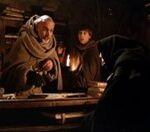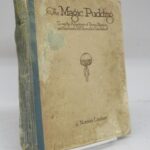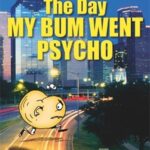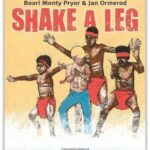Our Heritage… of Humour
By Phillipa Carmody
Humour serves us well and the NCACL houses a lot of it. From early Australian writings and illustrations through to the present day, our humour not only entertains us but helps us in a range of ways. This is certainly true for children.
Humour works wonders in our lives – lightening our load by pouring oil on troubled waters, helping us deal with upsetting emotions, explaining the awkward and, perhaps most significantly, in bonding us. We enjoy sharing funny things. The sheer volume of entertaining memes doing the rounds in these difficult times attests to this. Humour makes us feel like we are not alone. Even if we are only sharing levity with the author, there is someone out there who thinks like us.
Optimism can spring from humour. Aristotle maintained in his lost volume on comedy, Poetics, that humour can aid in revealing truth.
 Umberto Eco’s The Name Of The Rose centres on a physically and metaphorically blind monk, Jorge of Burgos, a librarian in a medieval, monastic library. He believes that laughter is the work of the devil and has a supposed second copy of Poetics in a forbidden room in the library. Jorge sets traps to kill any monk who attempts to read it. We’re shocked and amused at the ludicrousness of this. We take humour for granted, as being intrinsic to the human condition – universal. Funny things aren’t banned from our libraries.
Umberto Eco’s The Name Of The Rose centres on a physically and metaphorically blind monk, Jorge of Burgos, a librarian in a medieval, monastic library. He believes that laughter is the work of the devil and has a supposed second copy of Poetics in a forbidden room in the library. Jorge sets traps to kill any monk who attempts to read it. We’re shocked and amused at the ludicrousness of this. We take humour for granted, as being intrinsic to the human condition – universal. Funny things aren’t banned from our libraries.
Indeed, fostering a sense of humour is part and parcel of bringing up our children. Many books written for children contain humour of different kinds and in differing amounts, through both the writing and illustrations. These books encourage our shared language of laughter and amusement.
Our wonderful NCACL houses a marvellous panoply of Australian children’s literature that is chock full of humour.
These books can stretch the child’s imagination, illustrating – both verbally or visually – fresh concepts, situations, ways of perceiving things and new ways of dealing with the unexpected or the difficult. These books help children feel like they are not alone.
Word play, rhyme, alliteration, incongruity, and logical fallacies abound. Strange or comical pictures fill many wonderful volumes.
The hilarious writings and drawings of Norman Lindsay’s The Magic Pudding, written in 1918, kick-started our heritage of whimsical bush humour. With its cranky endless pudding possessed of legs, arms and a face that talks, both children and adults enjoy the sense of the ridiculous. Satire lampooning societal attitudes of the day evidences our evolving attitudes around what is socially acceptable as humour. The same applies to the “naughty” koala, Blinky Bill (1933).
 More recently Andy Griffith’s The Day My Bum Went Psycho, (which my husband loved reading to our children – I can still see them all laughing together on the bed), with its over-the-top, basic humour in the writing and the pictures, outrageously stretches the imagination – laying out the possibilities of what we may talk and laugh about.
More recently Andy Griffith’s The Day My Bum Went Psycho, (which my husband loved reading to our children – I can still see them all laughing together on the bed), with its over-the-top, basic humour in the writing and the pictures, outrageously stretches the imagination – laying out the possibilities of what we may talk and laugh about.
Bob Graham’s terrific illustrations greatly enhance the books he has illustrated, entertaining viewers of any age.
At the other end of the spectrum Jackie French’s thought- provoking Hitler’s Daughter, though a serious book, contains some irony.
Shake a Leg by Boori Pryor and Jan Ormerod amusingly juxtaposes Aboriginal and Italian culture around dance and pizzas.
Craig Cormick’s range of humour in his ground-breaking novella, Superheroes For A Day, for ASD and neurotypical children, illuminates their different ways of thinking and being amused.
My Tales of Tildale is infused with a gentle and sometimes whimsical humour. A left-handed golfing cyclops requires a left-handed ball.
The NCACL’s collection is invaluable for entertainment and for a record of what we have given to our children since our first Australian books were printed.
 My new series of novels for primary-aged children, Tales of Tildale, is a creative departure from my portrait painting. Studying literature within my history/philosophy degree and reading a great many books to my children, is resulting in creations that are considerably more than the sum of those parts. These stories often try to write themselves and yes, the characters do fuss about their plotlines and dialogue. In the end I generally acquiesce.
My new series of novels for primary-aged children, Tales of Tildale, is a creative departure from my portrait painting. Studying literature within my history/philosophy degree and reading a great many books to my children, is resulting in creations that are considerably more than the sum of those parts. These stories often try to write themselves and yes, the characters do fuss about their plotlines and dialogue. In the end I generally acquiesce.
See also:
NCACL Catalogue subject humour
Posted by: NCACL | Published: 12 Jul 2025

That’s so true. Story and humour are also valuable ways to remember when learning
That’s a very good point, they do indeed.